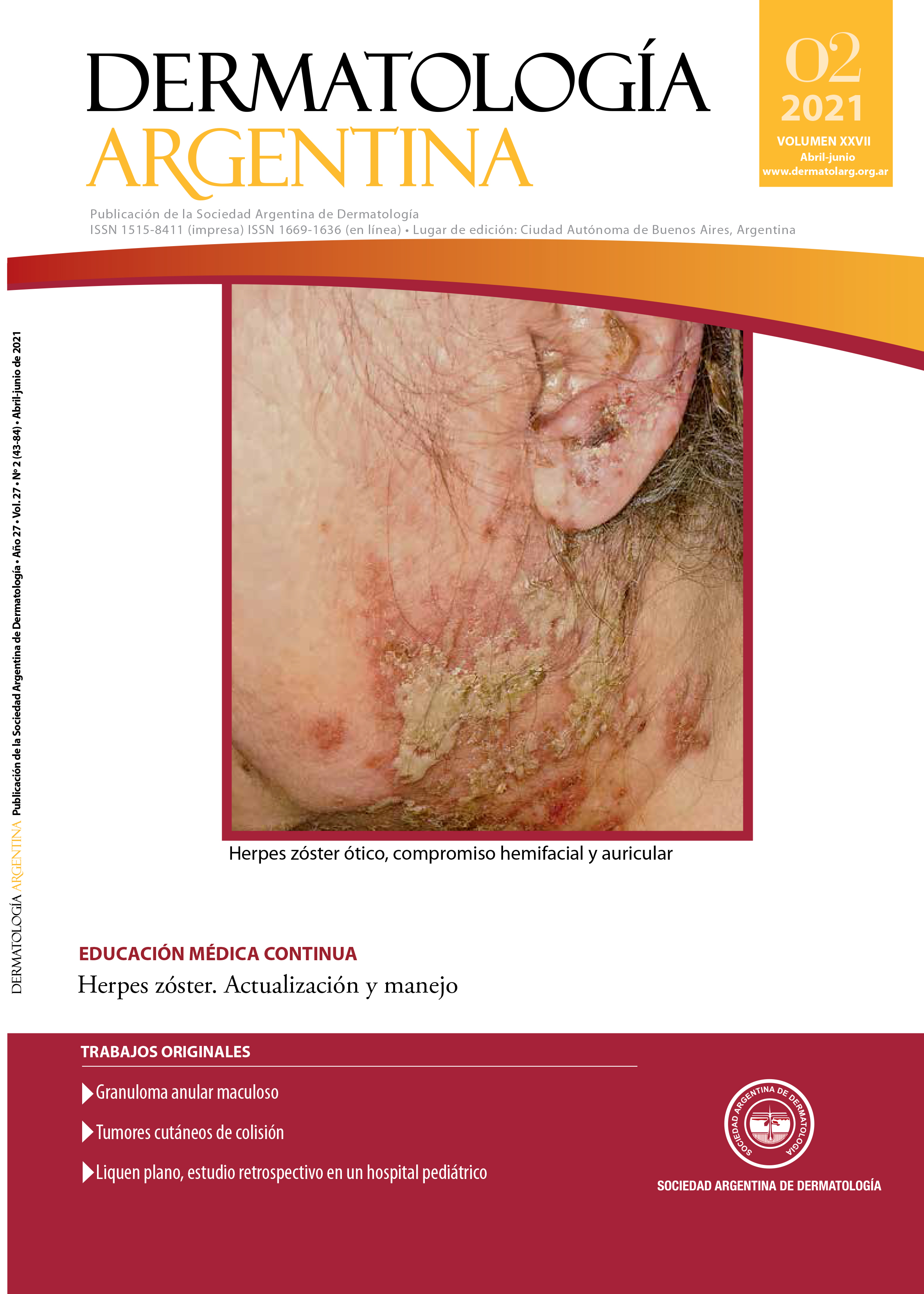Cutaneous collision tumors
DOI:
https://doi.org/10.47196/da.v27i2.2125Keywords:
collision tumors, collision neoplasmAbstract
Collision tumors consist of neoplasms composed of two different cell populations that maintain a clear differentiation of their borders, and that are adjacent to each other in the same histopathological sample. This association can correspond to two malignant tumors, two benign, or one malignant and one benign. They are infrequent and, at times, represent a clinical challenge for the correct detection of both neoplasms.
Three cases of cutaneous collision tumors of a melanocytic line combined with a keratinocytic line are presented, two of them in which both neoplasms were malignant and one that associated a malignant and a benign lesion.
References
I. Bulte CA, Hoegler KM, Khachemoune A. Collision tumors: A review of their types, pathogenesis, and diagnostic challenges. Dermatol Ther. 2020;33e14236.
II. Gulia A, Altamura D, De Trane S, Micantonio T, et ál. Pigmented reticular structures in basal cell carcinoma and collision tumours. Br J Dermatol. 2010;162:442-444.
III. Cornejo KM, Deng AC. Malignant melanoma within squamous cell carcinoma and basal cell carcinoma: is it a combined or collision tumor: a case report and review of the literature. Am J Dermatopathol. 2013;35:226-234.
IV. Rodríguez Saá S, Ciancio RM, Ruiz LR, Villa RE. Tumores en colisión: queratosis seborreica con nevus melanocítico. Estudio dermatoscópico e histopatológico a propósito de dos lesiones. Dermatol Argent 2011;17:405-408.
V. Novick M, Gard DA, Hardy SB, Spira M. Burn scar carcinoma: a review and analysis of 46 cases. J Trauma 1977;17:809-817.
VI. Bhawan J, Mehregan AH, Jung-Legg Y, Gellis SE. Pigmented basal cell carcinoma and superficial spreading malignant melanoma: an unusual combination. J Cutan Pathol. 1984;11:471-475.
VII. Blum A, Siggs G, Marghoob AA, Kreusch J, et ál. Collision skin lesions-results of a multicenter study of the International Dermoscopy Society (IDS). Dermatol Pract Concept. 2017;7:51-62.
VIII. Papa G, Grandi G, Pascone M. Collision tumor of malignant skin cancers: a case of melanoma in basal cell carcinoma. Pathol Res Pract 2006;202:691-694.
IX. Burkhalter A, White WL. Malignant melanoma in situ colonizing basal cell carcinoma. A simulator of invasive melanoma. Am J Dermatopathol. 1997;19:303-307.
X. Boyd AS, Rapini RP. Cutaneous collision tumors. An analysis of 69 cases and review of the literature. Am J Dermatopathol. 1994;6:253-257.
XI. Piérard GE, Fazaa B, Henry F, et ál. Collision of primary malignant neoplasms on the skin: the connection between malignant melanoma and basal cell carcinoma. Dermatology. 1997;194:378-379.
XII. Wang H, Benda PM, Piepkorn MW. Parasitism of basal cell carcinoma by lentigo maligna melanoma. J Am Acad Dermatol. 2003;48:S92-S94.
XIII. Rodriguez J, Nonaka D, Kuhn E, Reichel M, et ál. Combined high-grade basal cell carcinoma and malignant melanoma of the skin ("malignant basomelanocytic tumor"): report of two cases and review of the literature. Am J Dermatopathol. 2005;27:314-318.
XIV. Rosen LB, Williams WD, Benson J, Rywlin AM. A malignant neoplasm with features of both squamous cell carcinoma and malignant melanoma. Am J Dermatopathol. 1984;6:213-219.
XV. Erickson LA, Myers JL, Mihm MC, et ál. Malignant basomelanocytic tumor manifesting as metastatic melanoma. Am J Surg Pathol 2004;28:1393-1396.
XVI. Zaballos P, Llambrich A, Puig S, Malvehy J. Dermoscopy is useful for the recognition of benign-malignant compound tumours. Br J Dermatol. 2005;153:653-656.
XVII. Gulia A, Altamura D, De Trane S, et ál. Pigmented reticular structures in basal cell carcinoma and collision tumours. Br J Dermatol. 2010;162:442-444.
XVIII. Ansai S, Ogita A, Matsuda H, et ál. Collision of basal cell carcinoma and melanocytic nevus with unique dermoscopic findings. J Dermatol. 2016;43:584-585.
XIX. Zaballos-Diego P. Collision tumors. Actas Dermosifiliogr. 2014;105:310-311.
XX. Moscarella E, Rabinovitz H, Oliviero MC, et ál. The role of reflectance confocal microscopy as an aid in the diagnosis of collision tumors. Dermatology. 2013;227:109-117.
Downloads
Published
Issue
Section
License
Copyright (c) 2021 Dermatología Argentina

This work is licensed under a Creative Commons Attribution-NonCommercial-NoDerivatives 4.0 International License.
El/los autor/es tranfieren todos los derechos de autor del manuscrito arriba mencionado a Dermatología Argentina en el caso de que el trabajo sea publicado. El/los autor/es declaran que el artículo es original, que no infringe ningún derecho de propiedad intelectual u otros derechos de terceros, que no se encuentra bajo consideración de otra revista y que no ha sido previamente publicado.
Le solicitamos haga click aquí para imprimir, firmar y enviar por correo postal la transferencia de los derechos de autor












